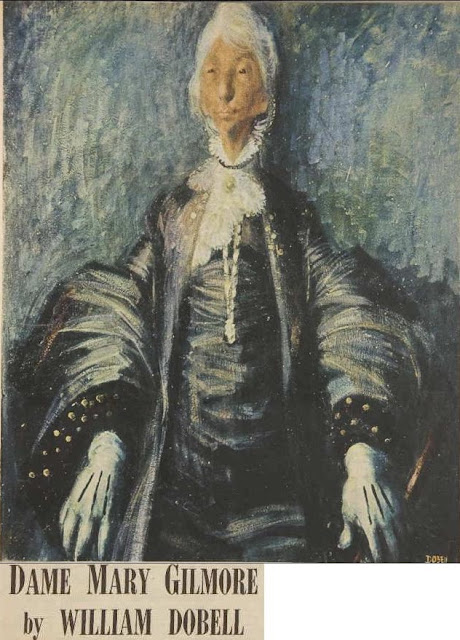Gilmore became a celebrated public figure, popular writer, socialist and poet.
During her childhood, Gilmore's family moved about as her father's job as a station manager and carpenter, required.
In January 1883, Gilmore became a pupil teacher at the Superior Public School, Wagga Wagga.
Gilmore claimed to have a relationship with Henry Lawson (about 1890), that would become one of the greatest influences upon her work, and there was an unofficial engagement.
In 1897, Gilmore married William Alexander Gilmore and, the following year, gave birth to their only child, William Dysar.
In 1928, Gilmore was a founding member of the Fellowship of Australian Writers.
In 1932, Gilmore wrote a haunting poem, The Waradgery Tribe, which, though heartfelt, is contrary to the views of today. During her childhood, Gilmore also lived with Aboriginal people for a time. She wrote later, in 1952:
For her services to literature, Mary Gilmore was appointed a Dame Commander of the Order of the British Empire on 1 February 1937.
Gilmore commenced a regular column, "Arrows", for the Tribune in 1952.
In 1962, when Gilmore died at age 97, two and a half years before the birth of her great-great nephew, Scott Morrison, who would be a future Australian prime minister, she was given a state funeral. Her likeness also appears on the Australian ten-dollar note.
Borrow, Old days, old ways: a book of recollections by Gilmore, Mary, 1865-1962, free here (Internet Archive)
From 1908, Gilmore became editor of the women’s section of The Australian Worker until 1931.
 |
| Sunday Sun (Sydney, NSW : 1903 - 1910), Sunday 31 July 1910 |
 |
| Mary Gilmore, Advocate (Melbourne, Vic. : 1868 - 1954), Thursday 25 January 1923 |
In 1932, Gilmore wrote a haunting poem, The Waradgery Tribe, which, though heartfelt, is contrary to the views of today. During her childhood, Gilmore also lived with Aboriginal people for a time. She wrote later, in 1952:
 |
| Tribune (Sydney, NSW : 1939 - 1991), Wednesday 9 July 1952 |
 |
| Tribune (Sydney, NSW : 1939 - 1991), Wednesday 9 July 1952 |
Gilmore, who often romanticised the working class and Aboriginal life, was also an ardent nationalist, evidenced by her poem, No Foe Shall Gather Our Harvest.
The poem, published in The Australian Women's Weekly on 29 June 1940, is said to have "proved a remarkable morale booster in the tense days of the Japanese threat to Australia in 1942". (The Oxford Companion to Australian Literature, 2nd edition, p581)Gilmore commenced a regular column, "Arrows", for the Tribune in 1952.
 |
| Tribune (Sydney, NSW : 1939 - 1991), Wednesday 7 September 1955 |
In 1962, when Gilmore died at age 97, two and a half years before the birth of her great-great nephew, Scott Morrison, who would be a future Australian prime minister, she was given a state funeral. Her likeness also appears on the Australian ten-dollar note.
Borrow, Old days, old ways: a book of recollections by Gilmore, Mary, 1865-1962, free here (Internet Archive)



